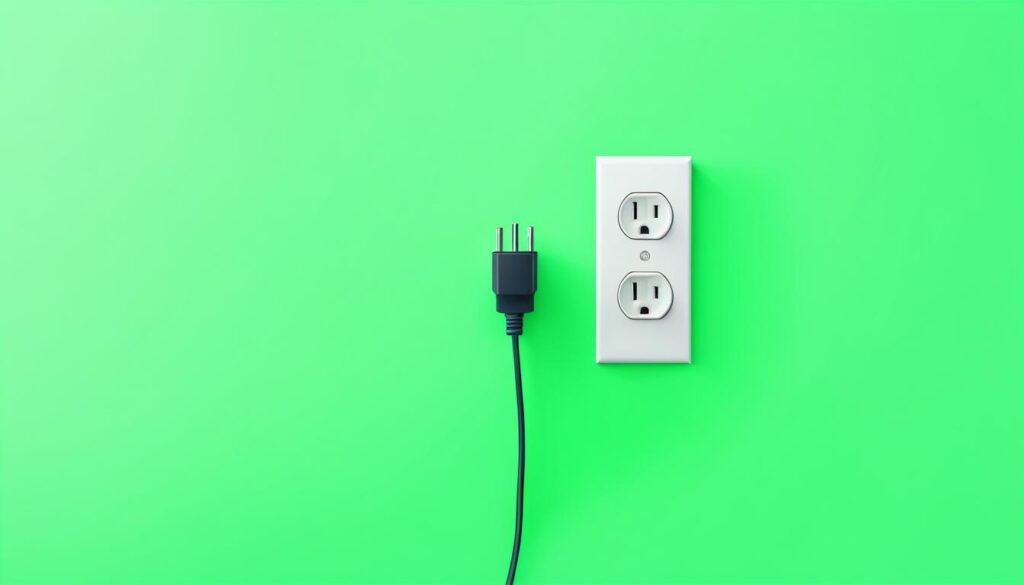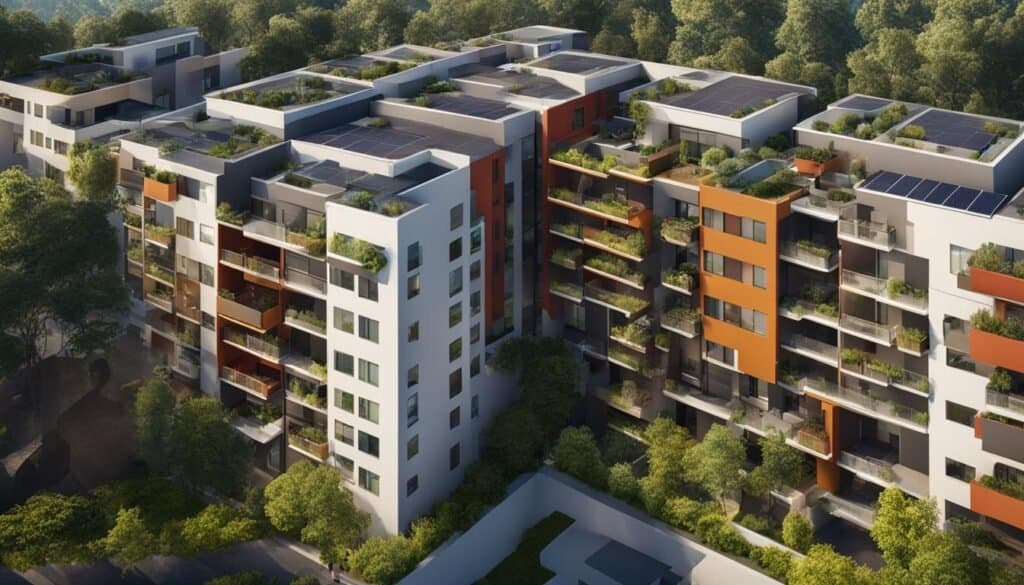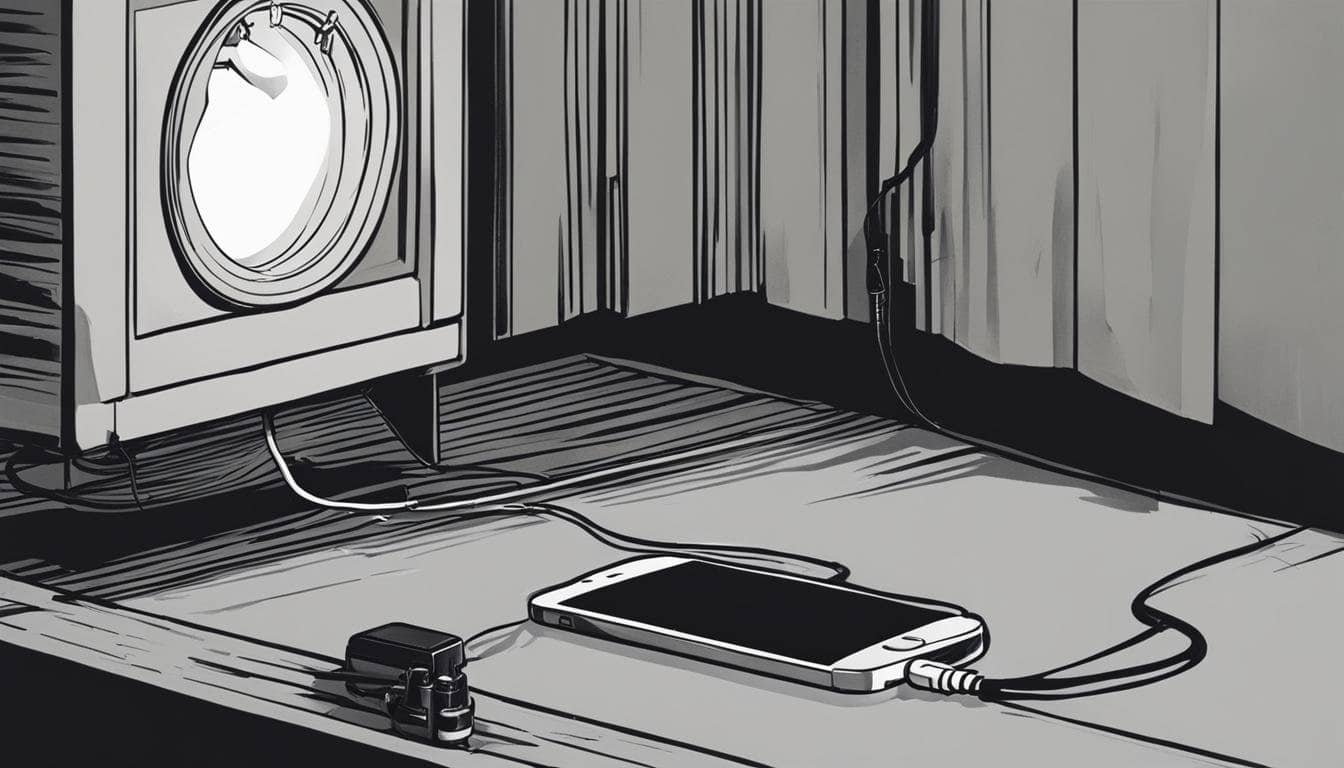As a previous apartment dweller, I’m always searching for innovative ways to save energy and reduce my utility bill. I’ve discovered that making my living space more energy-efficient doesn’t require extensive or expensive renovations. In fact, there are numerous energy-saving strategies for apartments that any renter can easily implement. By applying these tactics, not only can we trim our energy bills, but we also contribute to a greener environment for everyone.
Key Takeaways
- Effortlessly reduce energy costs with simple lighting upgrades and efficient bulb choices
- Practice energy-conscious habits, including unplugging “vampire appliances” when not in use
- Make the most of water conservation efforts with energy-efficient showerheads and low-flow faucets
- Explore the benefits of programmable thermostats for automated temperature control to optimize energy savings
- Ensure optimal appliance use through proper temperature settings and maintenance
- Address drafts and air leaks with affordable insulation and sealing techniques
- Collaborate with landlords to implement larger-scale energy efficiency improvements
Top 17 Eco-Tips Renters Can Take Advantage of Now
1. Replace old lightbulbs with LEDs
- LED bulbs use at least 75% less energy and last 25 times longer than incandescent bulbs.
- Replace the most frequently used bulbs first. Prioritize the kitchen, living room, and bedrooms.
2. Use power strips for electronics and turn off when not in use
- TVs, laptops, and phone chargers use energy even when turned off. This “phantom” load accounts for up to 10% of home energy use.
- Plug electronics into power strips. Turn the strips off when equipment is not in use to eliminate standby power.
3. Adjust the thermostat
- Turning your thermostat back 10°-15°F for 8 hours a day can save 5%–15% on heating and cooling bills.
- Programmable thermostats make temperature adjustment easy. Ask your landlord about installing one.
4. Use curtains and blinds
- Windows account for up to 25% heat loss in winter and heat gain in summer.
- Close blinds and curtains at night and on sunny days to help insulate. Open them during winter days to let sunlight in.
5. Seal air leaks
- Drafts from leaky windows, doors, and outlets can increase heating and cooling costs 10% or more.
- Use caulk, weather stripping, outlet gaskets, and draft stoppers to seal leaks. Get landlord approval first.
6. Use area rugs
- Bare floors can account for 20% of heat loss in a home.
- Use area rugs on hardwood, tile, and other bare floors to provide insulation.
7. Adjust water heater temperature
- Water heating accounts for 14%–18% of home energy bills.
- Turn down the water heater to 120°F. Install low-flow showerheads for additional savings.
8. Run full loads in dishwasher and washing machine
- Running partial loads can waste up to 3700 gallons of water per year.
- Accumulate full loads before running appliances to maximize efficiency.
9. Line dry clothes
- Clothes dryers account for 6% of a home’s energy use.
- Hang-dry clothes on a rack or clothesline to eliminate dryer energy use.
10. Cook efficiently
- Ovens, stoves and ranges account for 5%–10% of home energy bills.
- Match pan size to burner size, use lids, and turn off equipment before cooking time ends.
11. Unplug unused refrigerators and freezers
- Extra refrigerators and freezers can use 4 times more power than new efficient models.
- Check with your landlord before unplugging additional units.
12. Use microwave for cooking when possible
- Microwaves use 50%–80% less energy than conventional ovens.
- Prepare single servings and leftovers in the microwave rather than oven.
13. Install low-flow faucet aerators
- Low-flow aerators cut water flow by 30%–60% with no noticeable difference.
- Ask landlord before installing. Aerators screw onto most faucet heads.
14. Take shorter showers
- Reducing shower time from 10 minutes to 5 minutes saves 12.5 gallons per shower.
- Challenge yourself to 5 minute showers. Time yourself or use a timer.
15. Report drafts, leaks, and other issues
- Equipment problems like refrigerant leaks can more than double HVAC energy use.
- Notify your landlord about any drafts, leaks, dripping faucets, or other problems.
16. Use shades effectively
- Windows are responsible for 25%–30% of residential heating and cooling energy use.
- In winter, open southern-facing window shades during the day to allow in sunlight and close them at night. Do the opposite for summer.
17. Understand your energy bill
- Knowing how much energy you use and when allows you to identify problems and savings opportunities.
- Review usage details on monthly bills. Compare to previous months and seasons.
Lighting Efficiency: A Bright Idea for Renters
Energy-conscious apartment dwellers can significantly reduce their energy consumption and costs by implementing various energy-saving tips related to lighting. Simple actions such as upgrading to ENERGY STAR® certified bulbs, maximizing natural light, and turning off lights when not in use can substantially impact energy usage, resulting in a green and budget-friendly living environment.
Upgrade to ENERGY STAR® Certified Bulbs
Switching to ENERGY STAR® certified bulbs for frequently used light fixtures can save renters over $65 annually in energy costs. LEDs, a popular choice for energy-efficient bulbs, use up to 85% less energy compared to incandescent ones, significantly increasing energy efficiency. By promptly replacing outdated incandescent bulbs with ENERGY STAR® certified LEDs, renters can enjoy immediate and ongoing energy cost savings.
Maximizing Natural Light
Another effective way to save energy is by maximizing natural light in your living space. By strategically placing mirrors on walls opposite windows, you can increase natural light and decrease your reliance on artificial lighting during daytime hours. Moreover, keeping windows clean and removing any obstructions can further enhance the flow of sunlight into your apartment, contributing to a bright and inviting atmosphere without additional energy consumption.
The Impact of Turning Off Lights
Believe it or not, simply remembering to turn off lights when not in use can substantially decrease energy usage. In fact, ENERGY STAR® highlights that turning off a single 60-watt bulb that would typically burn for eight hours a day can lead to an annual saving of roughly $15 per year. Over time, these savings add up, and the cumulative impact is a greener, more energy-efficient living environment.
Unplug and Save: The Power of Energy-Conscious Habits
Electronic devices often continue drawing power even when turned off, contributing to unnecessary energy use. These so-called energy vampires can increase energy consumption and boost your electric bill. Unplugging “vampire appliances,” such as battery chargers and power adapters, when not in use, can curb energy wastage and help you save on energy costs.
One practical approach to disconnect multiple electronics simultaneously is using power strips. These multi-socket devices serve as a centralized control point, allowing you to turn off several connected appliances at once automatically. Organizing appliances in this manner can further reduce electricity usage and emissions that come with prolonged energy consumption.
Developing energy-conscious habits is essential to eliminate undue strain on our resources, the environment, and your wallet. By simply unplugging devices when not in use, remembering to switch off power-consuming equipment, and making an effort to turn appliances off with the help of power strips automatically, you can become an energy saver and contribute to a greener, more sustainable world.
Water Conservation: Streamlining Your Usage

As a renter, there are many steps you can take to reduce your water usage, save water, and decrease the energy required to heat it. Implementing water-saving techniques such as low-flow showerheads and faucets, altering your laundry habits, and optimizing your refrigerator and freezer settings can help you reduce your energy consumption and conserve water.
Energy-Efficient Showerheads and Their Savings
One effective way to save water is by installing an energy-efficient showerhead. A low-flow showerhead not only conserves water but also minimizes the energy required to heat it. According to ENERGY STAR®, a 10-minute shower with a low-flow showerhead can save about five gallons of water compared to a typical bath. This small change can have a substantial impact on your water usage and energy consumption over time.
Opting for Low-Flow Faucets
Low-flow faucets can also significantly contribute to water conservation in your home. An energy-efficient faucet minimizes water flow while still providing an adequate pressure level for daily use. By simply replacing your existing faucets with low-flow alternatives, you can substantially decrease your water usage and conserve this precious resource.
In addition to these water-saving fixtures, adjusting your household habits can also help you conserve water and energy. One example is to wash clothes in cold water. Switching to cold settings on your washing machine can cut a load’s energy consumption by half, as approximately 75% of the energy needed to wash clothes goes toward heating the water. Furthermore, setting your refrigerator and freezer to optimal temperatures enhances their efficiency, reducing energy consumption, and contributing to your water conservation efforts.
Taking the time to evaluate your water usage habits and making necessary adjustments can not only save water but also reduce your energy expenditure. By simply adopting energy-efficient fixtures and making conscious choices about how you use water, you can make a significant difference in your home’s overall energy usage and environmental impact.
Thermostat Efficiency: Automated Temperature Control
For apartment dwellers seeking to save energy and money, thermostat management presents a significant opportunity. Renters can substantially reduce their energy usage by implementing a programmable thermostat or a smart thermostat, which allows for automatic adjustments of temperature settings during hours of absence or sleep. This proactive approach to heating and cooling control can translate to considerable energy savings.
ENERGY STAR® suggests that properly utilizing a programmable thermostat can result in annual savings of up to $150.
Another energy-efficient practice renters can adopt is to lower their thermostat by 7-10 degrees Fahrenheit for eight hours a day. This simple adjustment may lead to approximately 10% savings on heating and cooling bills annually, emphasizing the potential to effectively manage energy costs through informed thermostat use. The table below demonstrates potential savings from lowering the thermostat based on different scenarios:
| Decrease in Thermostat Settings | Hours per Day | Annual Energy Savings |
|---|---|---|
| 7°F | 8 hours | 8% |
| 8°F | 8 hours | 9% |
| 9°F | 8 hours | 10% |
| 10°F | 8 hours | 11% |
In conclusion, a keen focus on thermostat efficiency can significantly impact renters’ energy consumption and expenses. By embracing programmable or smart thermostats and mindfully adjusting temperature settings, it becomes possible to create a comfortable living space while conserving energy and reducing utility bills.
Optimal Appliance Use: Maximizing Energy Efficiency

As a renter, it’s essential to make the most of your energy-efficient home appliances, to save both energy and money. One simple way to achieve this is by adjusting the temperature settings of your appliances to recommended levels, such as keeping refrigerators at 36°-38°F and freezers at 0°F, while setting water heaters to 120°F. This will allow you to reduce your energy usage while ensuring optimal performance.
Another effective strategy for enhancing the efficiency of appliances such as refrigerators is to clean their condenser coils annually. This simple maintenance task can improve their efficiency by up to 30%, resulting in significant energy and cost savings. Additionally, opting for Energy Star certified models for the appliances that consume electricity will help you save even more energy and money in the long run.
When cooking, it’s helpful to use strategies that minimize energy use. For example, covering pots on the stovetop will conserve heat and reduce cooking time, and using microwaves instead of conventional ovens can consume up to 70% less energy. The table below compares energy usage for a few common cooking tasks for both microwave and conventional oven:
| Cooking Task | Microwave Energy Usage (kWh) | Conventional Oven Energy Usage (kWh) |
|---|---|---|
| Warming a plate of leftovers | 0.04 | 0.26 |
| Baking a potato | 0.10 | 0.87 |
| Roasting a chicken | 0.66 | 3.6 |
As the table illustrates, using a microwave for everyday cooking tasks can significantly reduce energy consumption, allowing you to save on both energy and water resources.
In conclusion, making the most of your home appliances by adjusting temperature settings, maintaining them regularly, and using energy-efficient cooking strategies can help you maximize energy efficiency in your rental space. These small adjustments will not only save you money but also contribute to a more sustainable future by conserving valuable resources.
Insulation and Sealing: Combatting Drafts and Leaks
A well-insulated and sealed living space not only offers increased comfort, but also plays a crucial role in energy conservation. By implementing effective insulation and sealing practices, renters are able to reduce energy usage and maintain a consistent temperature in their living environment. Let’s explore some effective methods to combat drafts and leaks.
Window Caulking for Better Insulation
One way to insulate your home and minimize heat loss is by caulking windows. Applying an appropriate caulk in gaps and cracks around window frames can make a significant difference in your home’s energy efficiency, and in turn, your heating and cooling bills. Properly sealed windows also help reduce drafts and external noise, further enhancing your living space’s overall comfort.
Draft-Proofing Your Home
A draft-free home is key to maintaining a comfortable temperature while conserving energy. One simple yet effective method for draft-proofing is to apply affordable weatherstripping materials around doors and windows. These materials are easy to install and can have a noticeable impact on energy savings. In addition, you can use towels or draft stoppers as temporary measures to block drafts around windows during the colder months.
Sealing air conditioner units properly and avoiding blocking air registers with furniture also play a vital role in reducing the effort required from heating and cooling systems. These measures help maintain consistent temperatures, enabling your heating and cooling devices to work more efficiently and use less energy.
Remember, insulating and sealing your living space not only leads to energy savings but also contributes to a more comfortable and environmentally friendly home environment.
Energy-Saving Strategies for Apartments: A Renter’s Guide to Efficiency

Maximizing energy efficiency in apartment or rental homes is an essential aspect of reducing energy bills, protecting the environment, and improving comfort. Renters can adopt a variety of simple behaviors and collaborate with landlords to enhance the energy-saving potential in their living spaces. In this section, we will discuss smart strategies for air conditioning and heating, practical appliance settings tips, and ways to encourage landlord collaboration for efficiency improvements.
Smart Strategies for Air Conditioning and Heating
One of the simplest ways to cut down on energy costs is by using window evaporative coolers or energy-efficient room air conditioners. These devices consume 10% less energy than standard models, making them more environmentally friendly and budget-conscious. Additionally, you can retain your home’s cool temperatures during hot days by keeping drapes closed, which reduces the need for air conditioning and allows you to start saving on your energy bill.
Practical Tips on Appliance Settings
Appliances account for a significant portion of energy consumption in rental homes. To reduce your energy use and lower your utility bills, check and insulate your water heater settings. This simple step can save up to 9% in water heating costs. Furthermore, you can adopt energy savings tips like setting optimal temperatures for refrigerators and freezers, which enhances their efficiency while conserving energy.
Encouraging Landlord Collaboration for Efficiency Improvements
Talking to your landlord about potential home improvements and modifications can result in higher energy efficiency and savings for both parties. As a renter, you can suggest upgrades or repairs that could contribute to energy savings while adhering to any lease requirements. Examples of renewable energy development options include installing solar panels or upgrading to ENERGY STAR® appliances. Remember, landlords have a vested interest in maintaining a well-cared-for property, so don’t hesitate to engage in a proactive dialogue.
In conclusion, there is no shortage of energy-saving strategies renters can implement in their apartments. By focusing on air conditioning and heating efficiencies, optimizing appliance settings, and collaborating with landlords, renters can support renewable energy development efforts and enjoy the benefits of a comfortable, energy-efficient living environment.
Conclusion on Energy-Saving Strategies for Apartments
Implementing energy-saving strategies for apartments allows renters like me to live more sustainably and lower our energy costs. With simple adjustments to lighting, electronics, and appliances, we can significantly reduce our overall energy consumption and utility bills. By being proactive in making these changes, I can enjoy a more comfortable and efficient living space while also contributing to the betterment of our planet.
Conserving energy can be as easy as swapping out light bulbs, unplugging devices, and using water-saving fixtures. Furthermore, it’s crucial to understand the importance of proper thermostat use and energy-efficient appliances. By working alongside our landlords, we can collaborate on larger efficiency projects that provide mutual benefits for both parties. Taking these initiatives not only helps reduce our electric bill but also lessens our environmental footprint.
Renters can actively participate in energy-saving strategies for their homes by making conscious choices in their day-to-day lives. Sealing leaks, optimizing appliance use, and establishing open communication with our landlords for home improvement projects are all practical ways to save energy, contribute to a greener world, and enjoy the financial perks that come alongside a lower utility bill. Now is the time to implement these changes and work towards a more sustainable living experience.
FAQ on Saving Tips For Your Apartment
Q: What type of light bulbs are the most energy efficient for an apartment?
A: Compact Fluorescent Lamps (CFLs) and Light Emitting Diodes (LEDs) are the most energy efficient types of light bulbs for an apartment, according to the Department of Energy. These types use 25-80 percent less energy than traditional incandescent bulbs and can help apartment dwellers and renters to save on their electricity bill.
Q: How does using a ceiling fan can help save energy in my apartment?
A: Using a ceiling fan can help to distribute warm or cold air throughout the room more evenly, reducing the need for a radiator or air conditioner to work harder. This can considerably reduce energy use and save electricity, providing a valuable energy saving tip for all renters.
Q: Is there a way to use my water heater more efficiently?
A: Yes, you can increase energy efficiency by setting your water heater’s thermostat to 120 degrees Fahrenheit. The Department of Energy estimates this can save up to 20 percent of the energy used by the heater, constituting an effective energy saving strategy for apartment renters.
Q: Why should I use cold water for washing clothes?
A: Using cold water for laundry can save a lot of energy. About 90 percent of the energy used by a washing machine goes to heating water. By switching to cold water, you can save a significant amount on your electricity bill.
Q: How do I optimize the use of an air conditioner to be more energy efficient?
A: To save energy while using an air conditioner, make sure to clean or replace filters regularly. A dirty filter will make your air conditioner work harder, wasting energy. Also, using a ceiling fan in conjunction with an air conditioner can help distribute air more evenly.
Q: Are there energy-saving tips involving a radiator?
A: Certainly! To save energy with a radiator, bleed it regularly. This is a no-cost way to ensure that it runs efficiently. Use a radiator key to release trapped air, helping the radiator to distribute heat more effectively. This can also save you money on energy costs.
Q: How can I talk to my landlord about energy saving?
A: When talking to your landlord about energy saving, propose changes that will not only help you save on your bills, but also increase the value or longevity of the property. Consider suggesting energy-efficient light bulbs, insulation, or energy-star approved appliances.
Q: How can doors and windows affect energy saving in an apartment?
A: Sealing gaps around doors and windows can prevent drafts, which can make your heating or cooling system work harder, wasting energy. Use weatherstripping or caulk to seal these gaps. This is a low-cost tip for saving energy in a home or apartment.
Q: What are energy vampires and how can I prevent them?
A: Energy vampires are devices that waste energy even when they’re not in use. For instance, electronics like TVs, computers, or toasters can still draw power even when turned off. A simple solution to this is to use a power strip and turn it off when the devices are not in use. This strategy can help save on energy costs.
Q: How does using a power strip help save energy?
A: A power strip can be used to turn off multiple devices at once, preventing them from drawing power in standby mode, a common source of energy waste. By using a power strip, cutting back your energy use can be as simple as flipping a switch, helping renters and apartment dwellers save energy and money.





Leave a Reply